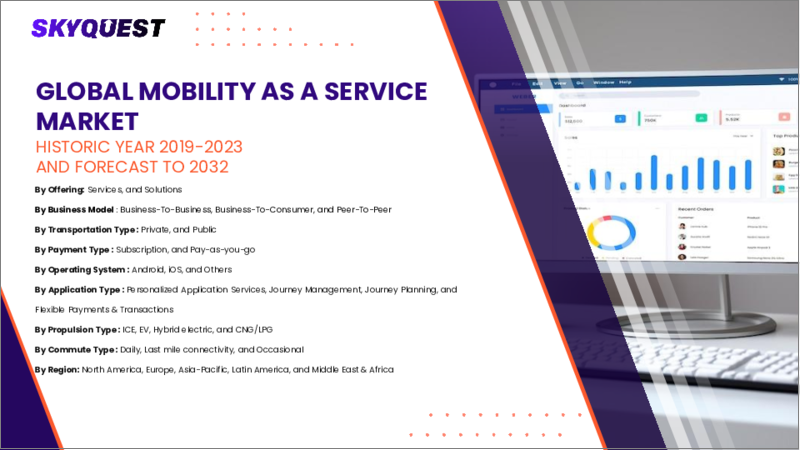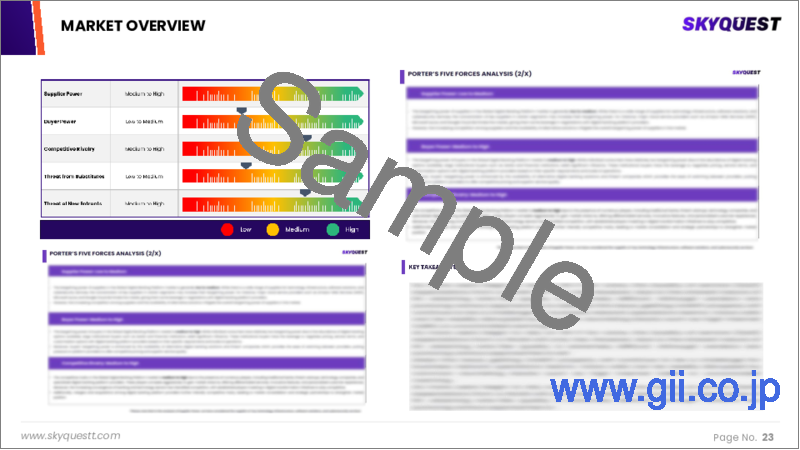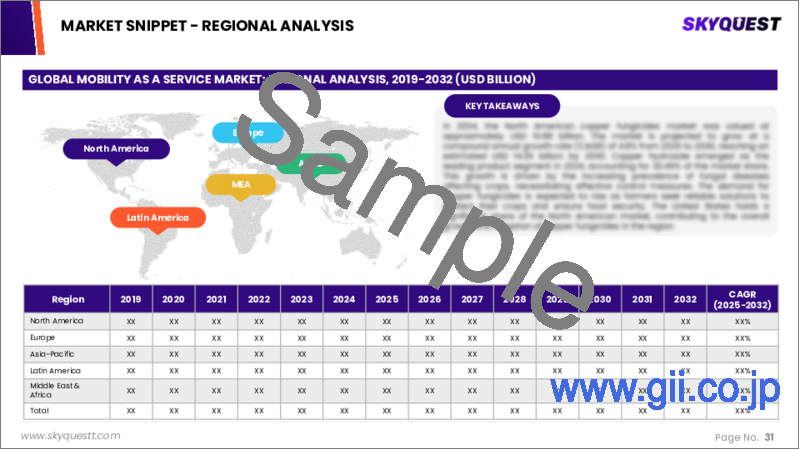|
|
市場調査レポート
商品コード
1628917
MaaS(Mobility As A Service)の市場規模、シェア、成長分析、サービス別、ビジネスモデル別、ソリューションタイプ別、輸送タイプ別、車両タイプ別、アプリケーションタイプ別、地域別 - 産業予測、2025年~2032年Mobility As A Service Market Size, Share, Growth Analysis, By Service, By Business Model, By Solution type, By Transporation type, By Vehicle type, By Application type, By Region - Industry Forecast 2025-2032 |
||||||
|
|||||||
| MaaS(Mobility As A Service)の市場規模、シェア、成長分析、サービス別、ビジネスモデル別、ソリューションタイプ別、輸送タイプ別、車両タイプ別、アプリケーションタイプ別、地域別 - 産業予測、2025年~2032年 |
|
出版日: 2025年01月08日
発行: SkyQuest
ページ情報: 英文 294 Pages
納期: 3~5営業日
|
全表示
- 概要
- 目次
世界のMaaS(Mobility As A Service)の市場規模は、2023年に57億米ドルとなり、2024年の74億7,000万米ドルから、2032年までには652億1,000万米ドルに成長し、予測期間(2025年~2032年)のCAGRは31.1%で成長する見通しです。
輸送部門は世界の大気汚染の主な原因であり、代替輸送手段へのシフトを促しています。MaaS(Mobility As A Service)市場は、共有モビリティ・ソリューションの人気の高まりにより成長の態勢を整えています。カーシェアリングは、所有に代わる費用対効果の高い選択肢となりつつあり、維持費や燃料費を削減すると同時に、環境への影響も緩和しています。可処分所得の増加と交通インフラへの投資が、この分野をさらに後押ししています。さらに、欧州連合委員会のような新興市場の政府イニシアティブは、ライドヘイリングサービスの採用にインセンティブを与えています。また、通勤者の間でe-bikeシェアリングの普及が進んでいることも注目に値します。効果的に排出量を削減し、時間を節約することで、持続可能な交通手段の魅力が全体的に高まっているからです。
目次
イントロダクション
- 調査目的
- 調査範囲
- 定義
調査手法
- 情報調達
- 二次データと一次データの方法
- 市場規模予測
- 市場の前提条件と制限
エグゼクティブサマリー
- 世界市場の見通し
- 供給と需要の動向分析
- セグメント別機会分析
市場力学と見通し
- 市場概要
- 市場規模
- 市場力学
- 促進要因と機会
- 抑制要因と課題
- ポーターの分析
主要な市場の考察
- 主要な成功要因
- 競合の程度
- 主要な投資機会
- 市場エコシステム
- 市場の魅力指数(2024年)
- PESTEL分析
- マクロ経済指標
- バリューチェーン分析
- 価格分析
- 技術分析
- 規制分析
- ケーススタディ分析
世界のMaaS(Mobility As A Service)市場規模:サービス別・CAGR(2025年~2032年)
- 市場概要
- 配車サービス
- カーシェアリング
- マイクロモビリティ
- バスシェアリング
- 鉄道サービス
世界のMaaS(Mobility As A Service)市場規模:ビジネスモデル別・CAGR(2025年~2032年)
- 市場概要
- 企業間取引
- 企業対消費者
- ピアツーピア
世界のMaaS(Mobility As A Service)市場規模:ソリューションタイプ別・CAGR(2025年~2032年)
- 市場概要
- テクノロジープラットフォーム
- 決済エンジン
- ナビゲーションソリューション
- 通信接続プロバイダー
- チケットソリューション
- 保険サービス
世界のMaaS(Mobility As A Service)市場規模:輸送タイプ別・CAGR(2025年~2032年)
- 市場概要
- プライベート
- 公共
世界のMaaS(Mobility As A Service)市場規模:車両タイプ別・CAGR(2025年~2032年)
- 市場概要
- バス
- 四輪車
- マイクロモビリティ
- 列車
世界のMaaS(Mobility As A Service)市場規模:アプリケーションタイプ別・CAGR(2025年~2032年)
- 市場概要
- パーソナライズされたアプリケーションサービス
- 旅程管理
- 旅程計画
- 柔軟な支払いと取引
世界のMaaS(Mobility As A Service)市場規模:オペレーティングシステム別・CAGR(2025年~2032年)
- 市場概要
- Android
- iOS
- その他
世界のMaaS(Mobility As A Service)市場規模:推進タイプ別・CAGR(2025年~2032年)
- 市場概要
- ICE
- EV
- ハイブリッド電気
- CNG/LPG
世界のMaaS(Mobility As A Service)市場規模:決済タイプ別・CAGR(2025年~2032年)
- 市場概要
- サブスクリプション
- 従量課金制
世界のMaaS(Mobility As A Service)市場規模:通勤形態別・CAGR(2025年~2032年)
- 市場概要
- 毎日
- ラストマイル接続
- 時々
世界のMaaS(Mobility As A Service)市場規模・CAGR(2025年~2032年)
- 北米
- 米国
- カナダ
- 欧州
- ドイツ
- スペイン
- フランス
- 英国
- イタリア
- その他欧州
- アジア太平洋
- 中国
- インド
- 日本
- 韓国
- その他アジア太平洋
- ラテンアメリカ
- ブラジル
- その他ラテンアメリカ
- 中東・アフリカ
- GCC諸国
- 南アフリカ
- その他中東・アフリカ
競合情報
- 上位5社の比較
- 主要企業の市場ポジショニング(2024年)
- 主な市場企業が採用した戦略
- 市場の最近の動向
- 企業の市場シェア分析(2024年)
- 主要企業の企業プロファイル
- 会社概要
- 製品ポートフォリオ分析
- 企業のセグメント別シェア分析
- 収益の前年比比較(2022年~2024年)
主要企業プロファイル
- Uber Technologies Inc
- Lyft, Inc.
- Didi Chuxing Technology Co., Ltd.
- BlaBlaCar
- Ola Cabs
- Gett, Inc.
- Grab Holdings Inc.
- Careem Networks FZ-LLC
- Taxify OU
- Moovel Group GmbH
- DiDi Express
- Transit App, Inc.
- SkedGo Pty Ltd
- Lime(Neutron Holdings Inc.)
- Bird Rides Inc.
- Spin(Ford Motor Company)
- JUMP Bikes(Uber Technologies, Inc.)
- Car2Go(Daimler AG)
結論と提言
Global Mobility As A Service (MaaS) Market size was valued at USD 5.7 billion in 2023 and is poised to grow from USD 7.47 billion in 2024 to USD 65.21 billion by 2032, growing at a CAGR of 31.1% during the forecast period (2025-2032).
The transportation sector is a major contributor to global air pollution, prompting a shift towards alternative modes of transport. The Mobility as a Service (MaaS) market is poised for growth due to the rising popularity of shared mobility solutions. Car-sharing is becoming a cost-effective alternative to ownership, reducing maintenance and fuel expenses while also mitigating environmental impact. Increased disposable income and investment in transport infrastructure further bolster this sector. Additionally, government initiatives in emerging markets, such as those from the European Union Commission, incentivize the adoption of ride-hailing services. The growing prevalence of e-bike sharing among commuters is also noteworthy, as it effectively cuts emissions and saves time, enhancing the overall appeal of sustainable transport options.
Top-down and bottom-up approaches were used to estimate and validate the size of the Global Mobility As A Service (Maas) market and to estimate the size of various other dependent submarkets. The research methodology used to estimate the market size includes the following details: The key players in the market were identified through secondary research, and their market shares in the respective regions were determined through primary and secondary research. This entire procedure includes the study of the annual and financial reports of the top market players and extensive interviews for key insights from industry leaders such as CEOs, VPs, directors, and marketing executives. All percentage shares split, and breakdowns were determined using secondary sources and verified through Primary sources. All possible parameters that affect the markets covered in this research study have been accounted for, viewed in extensive detail, verified through primary research, and analyzed to get the final quantitative and qualitative data.
Global Mobility as a Service (MaaS) Market Segmental Analysis
Global Mobility As A Service (MaaS) Market is segmented by Service, Business Model, Solution type, Transporation type, Vehicle type, Application type, Operating System, Propulsion Type, Payment Type, Commute Type, Daily, Last mile connectivity, Occasional and region. Based on Service, the market is segmented into Ride-Hailing, Car Sharing, Micro-Mobility, Bus Sharing and Train Services. Based on Business Model, the market is segmented into Business-To-Business, Business-To-Consumer and Peer-To-Peer. Based on Solution type, the market is segmented into Technology Platforms, Payment Engines, Navigation Solutions, Telecom Connectivity Providers, Ticketing Solutions and Insurance Services. Based on Transporation type, the market is segmented into Private and Public. Based on Vehicle type, the market is segmented into Buses, Four-Wheelers, Micro-Mobility and Trains. Based on Application type, the market is segmented into Personalized Application Services, Journey Management, Journey Planning and Flexible Payments & Transactions. Based on Operating System, the market is segmented into Android, iOS and Others. Based on Propulsion Type, the market is segmented into ICE, EV, Hybrid electric and CNG/LPG. Based on Payment Type, the market is segmented into Subscription and Pay-as-you-go. Based on Commute Type, the market is segmented into Daily, Last mile connectivity, and Occasional. Based on region, the market is segmented into North America, Europe, Asia Pacific, Latin America and Middle East & Africa.
Driver of the Global Mobility as a Service (MaaS) Market
One of the primary drivers of the Mobility as a Service (MaaS) market is the global push by governments to promote digital payment methods. Initiatives like India's Digital India program aim to foster cashless transactions and enhance digital payment infrastructure nationwide. Moreover, the surge in e-commerce businesses and the widespread adoption of e-wallets for transactions significantly contribute to market growth. Furthermore, during the forecast period, the development of advanced, secure payment gateways is anticipated to further propel the Mobility as a Service (MaaS) market, facilitating seamless and trustworthy transactions for users across various platforms.
Restraints in the Global Mobility as a Service (MaaS) Market
A significant challenge facing the Global Mobility as a Service (MaaS) market is the rising levels of transportation congestion and pollution, particularly in developing countries. The prevalence of single-occupancy vehicle trips exacerbates vehicle emissions and contributes to traffic congestion, a situation further intensified by the popularity of ride-hailing services. In response to these issues, many governments in these regions are actively encouraging the public to shift towards public transportation options instead of relying solely on Mobility as a Service solutions. This push for public transit, aimed at alleviating congestion and reducing environmental impact, poses a restraint on the expansion of the MaaS market.
Market Trends of the Global Mobility as a Service (MaaS) Market
The Global Mobility as a Service (MaaS) market is witnessing a dynamic trend fueled by the increasing engagement of power companies in the car-sharing sector, coupled with stringent emission regulations enforced by governments in developing economies. As urbanization accelerates and environmental concerns escalate, the demand for sustainable transportation solutions has surged, prompting traditional car manufacturers to pivot towards eco-friendly alternatives. This shift not only enhances corporate social responsibility but also allows MaaS providers to solidify their market presence through innovative services and partnerships. Consequently, the MaaS market is poised for substantial growth as it aligns with global sustainability goals and evolving consumer preferences.
Table of Contents
Introduction
- Objectives of the Study
- Scope of the Report
- Definitions
Research Methodology
- Information Procurement
- Secondary & Primary Data Methods
- Market Size Estimation
- Market Assumptions & Limitations
Executive Summary
- Global Market Outlook
- Supply & Demand Trend Analysis
- Segmental Opportunity Analysis
Market Dynamics & Outlook
- Market Overview
- Market Size
- Market Dynamics
- Drivers & Opportunities
- Restraints & Challenges
- Porters Analysis
- Competitive rivalry
- Threat of substitute
- Bargaining power of buyers
- Threat of new entrants
- Bargaining power of suppliers
Key Market Insights
- Key Success Factors
- Degree of Competition
- Top Investment Pockets
- Market Ecosystem
- Market Attractiveness Index, 2024
- PESTEL Analysis
- Macro-Economic Indicators
- Value Chain Analysis
- Pricing Analysis
- Technology Analysis
- Regulatory Analysis
- Case Study Analysis
Global Mobility As A Service (MaaS) Market Size by Service & CAGR (2025-2032)
- Market Overview
- Ride-Hailing
- Car Sharing
- Micro-Mobility
- Bus Sharing
- Train Services
Global Mobility As A Service (MaaS) Market Size by Business Model & CAGR (2025-2032)
- Market Overview
- Business-To-Business
- Business-To-Consumer
- Peer-To-Peer
Global Mobility As A Service (MaaS) Market Size by Solution type & CAGR (2025-2032)
- Market Overview
- Technology Platforms
- Payment Engines
- Navigation Solutions
- Telecom Connectivity Providers
- Ticketing Solutions
- Insurance Services
Global Mobility As A Service (MaaS) Market Size by Transporation type & CAGR (2025-2032)
- Market Overview
- Private
- Public
Global Mobility As A Service (MaaS) Market Size by Vehicle type & CAGR (2025-2032)
- Market Overview
- Buses
- Four-Wheelers
- Micro-Mobility
- Trains
Global Mobility As A Service (MaaS) Market Size by Application type & CAGR (2025-2032)
- Market Overview
- Personalized Application Services
- Journey Management
- Journey Planning
- Flexible Payments & Transactions
Global Mobility As A Service (MaaS) Market Size by Operating System & CAGR (2025-2032)
- Market Overview
- Android
- iOS
- Others
Global Mobility As A Service (MaaS) Market Size by Propulsion Type & CAGR (2025-2032)
- Market Overview
- ICE
- EV
- Hybrid electric
- CNG/LPG
Global Mobility As A Service (MaaS) Market Size by Payment Type & CAGR (2025-2032)
- Market Overview
- Subscription
- Pay-as-you-go
Global Mobility As A Service (MaaS) Market Size by Commute Type & CAGR (2025-2032)
- Market Overview
- Daily
- Last mile connectivity
- Occasional
Global Mobility As A Service (MaaS) Market Size & CAGR (2025-2032)
- North America (Service, Business Model, Solution type, Transporation type, Vehicle type, Application type, Operating System, Propulsion Type, Payment Type, Commute Type)
- US
- Canada
- Europe (Service, Business Model, Solution type, Transporation type, Vehicle type, Application type, Operating System, Propulsion Type, Payment Type, Commute Type)
- Germany
- Spain
- France
- UK
- Italy
- Rest of Europe
- Asia Pacific (Service, Business Model, Solution type, Transporation type, Vehicle type, Application type, Operating System, Propulsion Type, Payment Type, Commute Type)
- China
- India
- Japan
- South Korea
- Rest of Asia-Pacific
- Latin America (Service, Business Model, Solution type, Transporation type, Vehicle type, Application type, Operating System, Propulsion Type, Payment Type, Commute Type)
- Brazil
- Rest of Latin America
- Middle East & Africa (Service, Business Model, Solution type, Transporation type, Vehicle type, Application type, Operating System, Propulsion Type, Payment Type, Commute Type)
- GCC Countries
- South Africa
- Rest of Middle East & Africa
Competitive Intelligence
- Top 5 Player Comparison
- Market Positioning of Key Players, 2024
- Strategies Adopted by Key Market Players
- Recent Developments in the Market
- Company Market Share Analysis, 2024
- Company Profiles of All Key Players
- Company Details
- Product Portfolio Analysis
- Company's Segmental Share Analysis
- Revenue Y-O-Y Comparison (2022-2024)
Key Company Profiles
- Uber Technologies Inc
- Company Overview
- Business Segment Overview
- Financial Updates
- Key Developments
- Lyft, Inc.
- Company Overview
- Business Segment Overview
- Financial Updates
- Key Developments
- Didi Chuxing Technology Co., Ltd.
- Company Overview
- Business Segment Overview
- Financial Updates
- Key Developments
- BlaBlaCar
- Company Overview
- Business Segment Overview
- Financial Updates
- Key Developments
- Ola Cabs
- Company Overview
- Business Segment Overview
- Financial Updates
- Key Developments
- Gett, Inc.
- Company Overview
- Business Segment Overview
- Financial Updates
- Key Developments
- Grab Holdings Inc.
- Company Overview
- Business Segment Overview
- Financial Updates
- Key Developments
- Careem Networks FZ-LLC
- Company Overview
- Business Segment Overview
- Financial Updates
- Key Developments
- Taxify OU
- Company Overview
- Business Segment Overview
- Financial Updates
- Key Developments
- Moovel Group GmbH
- Company Overview
- Business Segment Overview
- Financial Updates
- Key Developments
- DiDi Express
- Company Overview
- Business Segment Overview
- Financial Updates
- Key Developments
- Transit App, Inc.
- Company Overview
- Business Segment Overview
- Financial Updates
- Key Developments
- SkedGo Pty Ltd
- Company Overview
- Business Segment Overview
- Financial Updates
- Key Developments
- Lime (Neutron Holdings Inc.)
- Company Overview
- Business Segment Overview
- Financial Updates
- Key Developments
- Bird Rides Inc.
- Company Overview
- Business Segment Overview
- Financial Updates
- Key Developments
- Spin (Ford Motor Company)
- Company Overview
- Business Segment Overview
- Financial Updates
- Key Developments
- JUMP Bikes (Uber Technologies, Inc.)
- Company Overview
- Business Segment Overview
- Financial Updates
- Key Developments
- Car2Go (Daimler AG)
- Company Overview
- Business Segment Overview
- Financial Updates
- Key Developments





